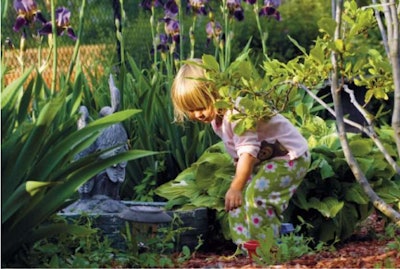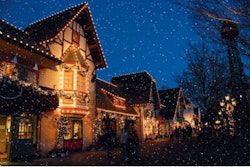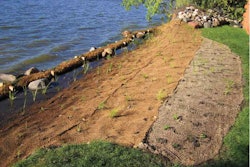
Lessons learned from public spaces can help your projects be more profitable
Just beyond Brookgreen Garden’s main path canopied by live oaks and their feathery Spanish moss, lies the Garden Room for Children, a small nook for young patrons to play and explore. The area includes butterfly-attracting flowers, areas to climb and hide, plaques with verses of poetry and sculptures of children and animals.
“Our goal is to get kids interested in both nature and art at a young age,” says Sara Millar, Manager of Horticulture at Brookgreen Gardens.
Famous for its American sculpture and native plants, Brookgreen Gardens, located in Murrells Inlet, South Carolina is one of the world’s largest outdoor sculpture gardens. Once the site of four rice plantations, the area hosts 250,000 visitors a year, 25,000 of them whom are children.
(above) Young visitors to Brookgreen Garden’s children’s garden enjoy things just their size.While children aren’t paying the bills directly, more and more landscape architects and contractors are keeping their desires and needs in mind when designing and caring for landscapes. For many, including children in the equation is a must.
“To one degree or another, all landscapes must have a children’s component, especially in a residential market,” says Chris James, owner of Chris James Landscaping in Midland Park, New Jersey and a consultant for Vander Kooi and Associates, a landscape consulting company. “Whether the client has small children or not, he eventually will be selling his home. If you don’t consider the child component you are limiting the pool of potential buyers.”
Against his advice, some long-term clients eliminated about 90 percent of the green space in their backyard by adding hardscaping, stonework and a greenhouse. “They were very lucky to sell it,” James said. The new owners, who have two small children, spent over $10,000 ripping up the landscape because it didn’t fit their lifestyle.
Landscapers should also include pictures of child-friendly landscapes in their portfolios. “When prospective clients see photos of children enjoying these spaces, they can imagine their children enjoying them too,” says Bob F. Brzuszek, an Associate Professor for the Department of Landscape Architecture at Mississippi State University.
Plants to stimulate the senses and fun
Stroking the supple leaves of a lambs ear plant, crushing and sniffing mint leaves, observing the metamorphism of a butterfly in a flower garden, children best learn through using all their senses. Choosing the appropriate plants for a landscape can help engage young explorers, and keep them safe. “I used to lead children on nature tours when I worked at an arboretum and let them freely pick wildflowers and grasses. Why not? We grew acres of them. I’d rather have them enjoy nature than be told to be afraid of it,” says Brzuszek.
(right) In their outdoor classrooms, students at The San Francisco School learn about community service, geology and botany through hands-on experiences.With any landscaping project, the positioning of plants and what types of plants to use are key areas to discuss with clients.
“Having my own kids helps me design for others,” says Chad Beidel, owner of Outside Solutions in Sykesville, Maryland. His three children are all under the age of seven. “For example, I avoid plants with thorns or prickly leaves in areas where the kids play. I also consider the views from inside the home. You want to be sure not to obstruct views that may prevent parents from keeping an eye on the kids.”
Avoid using plants such as yucca and agave, which have sharp edges, and, of course, don’t use poisonous plants in gardens where children may play. “Other than that, plant selection and design possibilities are endless,” says Millar. “Plants that attract insects and other wildlife to the garden are great to incorporate. Children also enjoy plants that appeal to their senses; brightly colored foliage in different shapes and textures, fragrant leaves and flowers, leaves that are fuzzy or interesting to the touch all make wonderful additions.”
James has worked with several clients who didn’t want their children around bees, so he limited planting pollinating flowers to areas where the children didn’t roam. “The parents are usually much more concerned about this than the kids, but it’s mom and dad writing the check.”
In his own yard, Beidel included a garden full of Black Eye Susans and Purple Cone Flowers, “for them to pick for Mommy,” he says. “The kids can pick the flowers safely and the flowers will re-bloom.”
Play time can be learning time an unusual garden in the heart of San Francisco, young students stretch their imaginations by constructing forts out of railroad ties, pound on rocks with shovels and hammers, sharpening their geology skills and analyze the parts of a flower through touch, taste and smell. “If the kids go home at the end of the day with dirt under their fingernails, grass stains on their pants and sand in their shoes, to me it was a successful day,” says Steve Morris, head of school at The San Francisco School.
(bottom left) Water features host a variety of plants and animals for children to study.The campus of The San Francisco School was designed by landscape architect Jeffrey Miller with the goal of creating open, natural spaces where students could have hands-on learning opportunities. The school yard includes a compost pile, goats, rabbits and an “adventure playground.”
Adventure playgrounds, like the one at The San Francisco School, include loose parts such as railroad ties and the use of natural elements such as rocks, sand and mud. By using raw materials, the children create their own playgrounds using initiative and creativity.
Richard Louv, the author of Last Child in the Woods, says it’s disheartening we don’t let children play naturally anymore. Today, many schools install “safe” play equipment and in some cases, even eliminate recess. “Play equipment is becoming so safe that they now lack the fun of playing on it,” says Brzuszek.
To be successful designing areas for children, take into consideration the various needs of the age groups. “Creating a diversity of spaces just their size,” says Brzuszek. “Things to crawl into, things to crawl on, places to splash in, places to dig and plant, places just for them.”
Fountains without water basins are wonderful places for children to explore and there is no risk of drowning. In most communities, a fence is not required for a fountain that has no basin. At The San Francisco School, Miller designed a rocky stream running through the campus raised just shoulder about chest level for preschoolers. They can enjoy the site, sound and feel of the water without the dangers that surround many water features.
Sherman Elementary School is one of several school yards in San Francisco designed by Miller Company Landscape Architects to provide green space for learning and playing.To increase students’ knowledge of storm water and water usage, Miller includes cisterns on other school campuses to catch roof water. The children are then able to pump the water and direct it where they want it to go.
Miller’s designs allow plenty of room for children to walk and play, and to help plant and maintain gardens. Parents and teachers promote environmental stewardship by explaining how important plants, insects and animals are to the ecosystem.
Kids become familiar with native plants and learn various concepts such as plant and insect identification, the life cycle and anatomy of plants, caring for the plants, composting and water conservation.
At The San Francisco School, opportunities for learning transcend the doors of the school house. “There is less structure and more opportunity,” says Morris.
There is also a lot of opportunity for landscapers who incorporate child-friendly practices into their portfolios. Designing for the littlest clients can pay big rewards.










